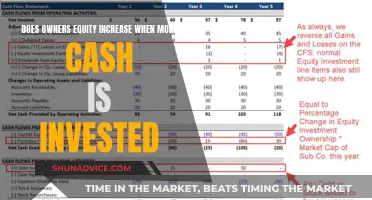
Technical analysis is a method used to predict price movements in the stock market by examining historical data, primarily price and volume. It involves using charts and other tools to identify trading signals and price patterns. Investing.com offers a range of technical analysis tools for different types of instruments, including stocks, currencies, commodities, bonds, and ETFs. The website provides real-time technical analysis summaries derived from moving averages and key technical indicators for specific time intervals. It covers various asset classes, such as equities, fixed income, commodities, and currencies. Additionally, Investing.com offers features like advanced portfolio management and customizable alerts for economic events and followed authors.
| Characteristics | Values |
|---|---|
| Instrument Types | Currencies, Indices, Commodities, Shares, Bonds, ETFs, Crypto |
| Analysis Type | Technical Analysis |
| Analysis Features | Trading signals, resistance and support levels, moving averages, oscillators, pivot points |
| Analysis Interval | 5 minutes to daily time frames |
| Analysis Tools | Candlestick patterns, technical indicators |
| Analysis Data | Securities from various asset classes including equities, fixed income, commodities and currencies |
| Analysis Action | Actionable technical analysis on both the cash and futures |
What You'll Learn

Moving averages
There are two main types of moving averages: the simple moving average (SMA) and the exponential moving average (EMA). A simple moving average is a calculation that takes the arithmetic mean of a given set of prices over a specific number of days in the past. It is the most widely used type of moving average and is called "simple" because each data point is equal-weighted in the calculation. The SMA can be 5-day, 13-day, 21-day, or any period of time that a trader finds useful.
An exponential moving average is similar to the SMA in that it measures the average trend of a stock price over a period of time, but it represents more current price swings as it gives greater weight to more current data. The EMA gives traders a more up-to-date moving average and can allow for the earlier discovery of price trends.
When choosing the right moving averages for your trading strategy, it's important to consider your trading time frame. For example, if you trade the hourly chart, use hourly moving averages, and if you trade the weekly chart, use weekly moving averages. It's also worth noting that moving averages don't predict future performance but rather confirm established trends.
Direct Investing: Strategies for Personal Finance Success
You may want to see also

Trading indicators
Trend-Following Indicators
These indicators help identify the direction of a stock's trend. Examples include:
- Moving Average (MA): Smooths out price trends by calculating average prices over a specific period. Includes simple, exponential, and weighted forms.
- Parabolic SAR: Uses trailing dots to highlight potential trend changes, confirming existing trends or indicating a slowdown.
- Average Directional Index (ADX): Measures trend strength, suggesting a strong trend when above 25 and no trend when below 20.
Momentum Indicators
Momentum indicators measure the strength of a stock's price movement in one direction over a given period and are best used with trend-following indicators. Examples include:
- Moving Average Convergence Divergence (MACD): Visualises the relationship between two trend-following moving averages, indicating increasing or decreasing momentum.
- Relative Strength Index (RSI): Measures the strength of a stock's price action and can identify overbought or oversold conditions.
- Stochastic Oscillator: Compares a stock's closing price to its price range over a specified period, helping identify potential trend reversals.
Volatility Indicators
Volatility indicators measure the likelihood of sudden and extreme price changes. Examples include:
- Bollinger Bands: Plots two standard deviations from a moving average, creating bands that track a stock's highs and lows to identify potential breakouts or reversals.
- Average True Range (ATR): Calculates the average price range of a stock over a specific period; higher ATR values indicate higher volatility.
- CBOE Volatility Index (VIX): Measures the market's expected price movement in the S&P 500 Index, plotted as a standalone chart.
Volume Indicators
Volume indicators represent the total number of shares traded in a stock during a given period. An example is:
- On-Balance Volume (OBV): Uses changes in cumulative trading volume to predict price changes, helping identify areas of buying and selling pressure.
- Volume-Weighted Average Price (VWAP): Calculates the average price a stock has traded throughout the day, adjusted for volume; Anchored VWAP is a modified version for any time period.
Support and Resistance Tools
Based on the theory that price has "memory," these tools identify price levels where buyers and sellers have previously acted, helping fine-tune entry and exit points and manage risk. Examples include:
Fibonacci: Indicators based on the Fibonacci sequence, including retracements, extensions, and channels.
It is important to remember that while trading indicators provide valuable insights, they do not guarantee future price movements. Traders should use them as tools to enhance their decision-making process, combining them with other forms of analysis and their own judgement to make more informed trades.
Coronavirus: Should You Move Investments to Cash?
You may want to see also

Support and resistance levels
Support represents a low level that a stock price reaches over time, while resistance represents a high level. Support is established when a stock price drops to a level that encourages traders to buy, causing the price to stop dropping and start rising. Conversely, resistance forms when a stock price rises to a level that prompts traders to sell, leading to a halt in the price increase and a subsequent decline.
Traders use support and resistance levels to determine strategic entry and exit points for trades. For example, if a stock price approaches a support level, it may indicate a good time to buy, expecting the price to bounce back up. On the other hand, if a stock price nears a resistance level, it could be a signal to sell, anticipating a potential price drop.
It is important to note that support and resistance levels are not exact prices but rather estimates or price zones. These levels can be horizontal or diagonal. Horizontal support and resistance levels are formed when a stock trades within a range, creating a clear boundary that the price struggles to break through. Diagonal support and resistance levels, on the other hand, are characteristic of trending markets. In an uptrend, diagonal support forms as the stock price makes higher lows, while diagonal resistance forms in a downtrend when the stock makes lower highs.
Identifying support and resistance levels is a
Cash on Hand: Strategic Investing and Opportunities
You may want to see also

Statistical analysis
The two most common forms of technical analysis are chart patterns and technical (statistical) indicators. Chart patterns involve identifying areas of support and resistance on a price chart, while technical indicators apply mathematical formulas to prices and volumes. Common technical indicators include moving averages, which smooth price data to make it easier to spot trends, and more complex indicators such as the moving average convergence divergence (MACD).
Technical analysts believe that past trading activity and price changes can be valuable indicators of future price movements. They assume that market prices reflect all available information, including economic, fundamental and news developments, and that price moves in trends and that history tends to repeat itself.
Technical analysis can be applied to any security with historical trading data, including stocks, futures, commodities, currencies and fixed-income securities. It is often used in conjunction with other forms of analysis, such as fundamental analysis, which focuses on a company's financial health and metrics.
While technical analysis can provide insights into potential trading opportunities, it has limitations and is not always accurate in predicting future price movements. It is important for traders to understand these limitations and combine technical analysis with other tools and strategies to make informed investment decisions.
A Beginner's Guide to Investing with Upstox
You may want to see also

Behavioural economics
Technical analysis, which seeks to predict price movements by examining historical data, can be viewed through the lens of behavioural economics. For example, investors may be reluctant to sell losing stocks because they want to avoid losses and get back to even, or they may be influenced by the herd mentality and follow the actions of the majority.
- Mental accounting: This refers to the tendency of people to allocate money for specific purposes. In investing, this could mean that investors are more willing to spend points, rewards, or miles earned through credit card rewards rather than paying for transactions directly with cash.
- Herd behaviour: Herd behaviour states that people tend to mimic the financial behaviours of the majority. In the stock market, this can lead to dramatic rallies and sell-offs. For example, investors may follow the actions of the majority and buy in bull markets and sell in bear markets.
- Emotional gap: The emotional gap refers to decision-making based on extreme emotions or emotional strains such as anxiety, anger, fear, or excitement. In investing, emotions can lead to irrational choices, such as holding on to losing positions rather than taking a loss.
- Anchoring: Anchoring refers to attaching a spending level to a certain reference. For example, investors may rationalise spending based on different satisfaction utilities. In technical analysis, investors may anchor their decisions to historical price data and charts.
- Self-attribution: Self-attribution refers to the tendency to make choices based on overconfidence in one's own knowledge or skill. In investing, this could lead to overconfidence in one's ability to predict future price movements based on technical analysis.
While behavioural economics can provide insights into the psychological factors influencing investment decisions, it is important to note that technical analysis has limitations and should not be solely relied upon when making investment decisions. Fundamental analysis, which focuses on a company's financials, should also be considered to make well-informed decisions.
Is Buying Furniture an Investment or Cash Flow Expense?
You may want to see also
Frequently asked questions
Technical analysis is the study of price movements using charts and historical data as a primary research tool. It helps traders and investors identify trading signals and price patterns to guide them on what is most likely to happen in the future.
Trading indicators are mathematical calculations plotted as lines on price charts that help traders identify signals and trends within a market. 'Leading' indicators attempt to forecast future price movements, while 'lagging' indicators look at past trends to indicate patterns of momentum.
Examples of trading indicators include the 'moving average' (MA), the exponential moving average (a form of MA), the moving average crossover strategy, the stochastic oscillator, and Fibonacci retracement.







